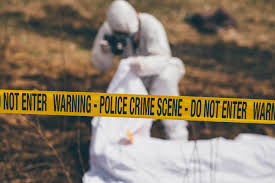Forensic thanatology:
The study of death and the dead for medicolegal purposes, offers critical insights into the journey of dead, from death of the dead to discovery of the dead. This exploration begins with the transition from clinical to somatic death, marked by the cessation of brain, heart, and lung functions, to molecular and finally cellular death.
The supravital period reveals the life of cells after death. It is a window where cells retain metabolic activity, crucial for estimating time since death. Factors like temperature, tissue type, and cause of death influence this period. Cellular death occurs through necrosis and apoptosis, each with distinct characteristics. Early and late signs of death, such as pallor, rigor, and decomposition, provide further clues.
Furthermore, several advancements in the detection, determination and estimation of somatic and cellular death are developed. The future research directions are promising, with major focus on advanced imaging, biomarker discovery, and refined estimation methods to improve medicolegal investigations and organ transplantation.
Background
Death is the complete and irreversible cessation of vital body parameters, viz. brain, heart, and lungs. Thanatology is study of death and the dead. It is derived from a Greek word “Thanatos” meaning death, and “logos” meaning science. Applying the knowledge of thanatology for medicolegal purposes is known as Forensic Thanatology. There is a progression from clinical death to brain death, biological death, and then cellular death.
Élie Metchnikoff is often credited with pioneering the field by establishing a scientific discipline dedicated to the study of death in 1903. A forensic investigation of the dead tells us the following information: · gives the confirmation that the person is dead.
· Helps determining the time period to harvest the organs.
· Helps us to determine the time since death.
Types of Death:
· Somatic Death
· Molecular Death
The time period between these two, i.e., Brain Stem Death and Cellular Death is the Supravital Period.
Materials and Methods
· SOMATIC DEATH
Somatic death particularly includes three stages. This theory is supported by two concepts Bichat’s tripod of life and Modern Concept.
· BICHAT’S TRIPOD:
1)Irreversible cessation/stoppage of the function of brain and brainstem
2)Irreversible cessation/stoppage of circulation
3)Irreversible cessation/stoppage of respiration
MODERN CONCEPT:

Complete and irreversible cessation of vital brainstem functions leads to brainstem death, i.e., somatic death. Reasons:
1.Brainstem consists of two important centres: respiratory centre and circulatory centre, essential to sustain life. Hence, when the brainstem dies it causes cessation of respiration and circulation.
2.Brainstem, along with cerebral cortex, is responsible for consciousness. Therefore, results in the cessation of nervous system.
SUPRAVITAL PERIOD
The supravital period refers to the time frame after somatic death. During this time, certain cells and tissues live on their leftover residual oxygen and retain some metabolic activity. It lasts 3-4 hours. During this period:
1. Bowel continues peristaltic movement
2. Cilia continue their movement
3. Spermatozoa remain motile in epididymis
4.WBCs retain their phagocytic movements
5. Excitability of muscles to different stimuli
Factors influencing the Duration of the Supravital Period: Temperature, Tissue Type, and Cause of Death.
CELLULAR DEATH
Cellular death is a complex, multi stage process that occurs at the cellular level due to the depletion of the reserved oxygen level in the body. Oxygen deficiency leads to metabolic dysfunction, which then leads to structural disintegration. It occurs after the supravital period and is characterized by biochemical changes. The pathways followed are

RESULTS:

ECG and EEG
.png)

Conclusion
Somatic Death, Supravital Period, and Cellular Death are the three stages of death, with unique characteristics. Their importance in Medico-legal Investigations is irrefutable. The following are their major applications:
Future Direction
There are still many challenges in fully understanding the supravital period. Research needs to focus on refining estimation methods.
· Advanced Imaging helps improve Cellular Activity Observation.
· Biomarker Discovery would aid in identification of new Death Indicators.
· Refined Methods help us better estimate Time Since Death (Essential in Medicolegal Investigations and Transplantation).
References
1. Reddy, K. S. N. (2017). The Essentials of Forensic Medicine and Toxicology (34 Ed.). Jaypee Brothers Medical Publishers.
2. Aggarwal, A. (2014). Textbook of Forensic Medicine and Toxicology (2 Ed.). Avichal Publishing Company nd th
3. Saukko, P., & Knight, B. (201 5). Knight's Forensic Pathology (4 Ed.). CRC Press

